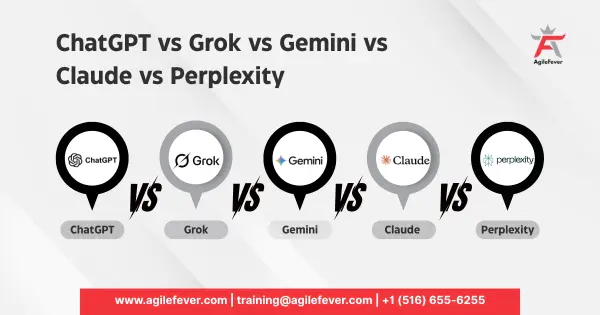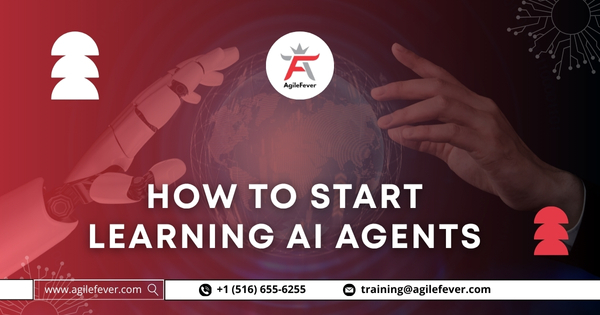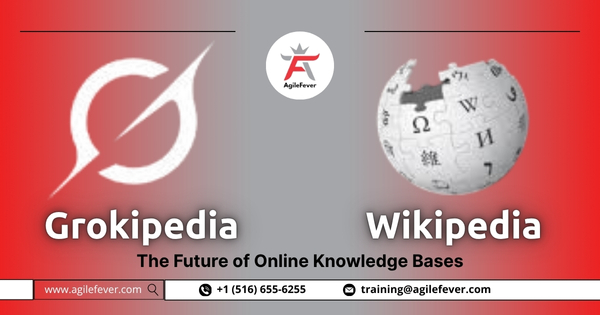If you are a content creator, a researcher, or a project manager, today’s AI models are built to fit specific needs and work styles. Don’t you think?
Among the most widely adopted names are ChatGPT, Grok, Gemini, Claude, and Perplexity. Each brings a unique skill set to the table. Some excel at creativity and coding, while others specialize in real-time updates, structured collaboration, or fact-checked research. Understanding these differences is key to choosing the one that complements your workflow rather than complicating it.
This detailed guide breaks down their strengths, best use cases, and ideal applications so you can make an informed decision about which AI aligns with your work and productivity goals.
Understanding the Modern AI Ecosystem
AI assistants today serve distinct professional needs. Some are built for creative thinking, others for real-time insights, and a few for enterprise-level data and research. Each model uses a different training approach and integrates with specific ecosystems, such as Google Workspace or social media platforms.
The goal is not to find a single best AI but to identify which one fits your context. For instance, a marketer tracking social trends may prefer Grok, while a researcher who relies on verified sources will find Perplexity more dependable.
Understanding the focus and architecture of each AI model helps you combine them strategically to get the best from every platform.
ChatGPT: The Creative Genius
ChatGPT, developed by OpenAI, is known for its versatility. It can write, analyze, code, and brainstorm with remarkable fluency. Designed to understand tone, context, and style, ChatGPT adapts to a wide variety of workflows, from creative projects to technical execution.
Best For:
Creative ideation, structured writing, coding assistance, and workflow automation.
Use Cases
- Writing blog posts, strategy documents, or presentations.
- Creating marketing copy, product descriptions, or social campaigns
- Debugging and explaining code.
- Generating scripts, training material, or learning plans.
- Building prompt-based automation workflows.
Strengths
- Multimodal capability: can understand text, images, and files.
- Advanced contextual understanding across long conversations.
- Adaptable tone for different audiences.
- Integrations and APIs for custom GPTs and business workflows.
Who It Is For:
Writers, developers, educators, consultants, and strategists who value adaptability, creativity, and structured output.
Pro Tip:
Use ChatGPT for content strategy and idea development. Create custom GPTs tailored to specific business processes such as marketing planning, analysis, or onboarding documentation.
Grok: The Real-Time Trend Expert
Created by xAI, Grok stands out for its real-time data access on X (formerly Twitter). It thrives on trending topics, social commentary, and public sentiment. If your work depends on understanding what is happening right now, Grok delivers instant cultural and conversational context.
Best For:
Social media trends, real-time updates, and content that requires immediacy.
Use Cases
- Monitoring trending discussions on X and summarizing them for reports.
- Writing sharp, witty, and viral social posts.
- Gauging public sentiment around products or topics.
- Generating commentary that reflects live events and reactions.
Strengths
- Real-time access to social data.
- Conversational tone with humor and insight.
- Excellent for reactive marketing and live engagement.
- Speeds up trend analysis and brand monitoring.
Who It Is For:
Marketers, journalists, social media strategists, and digital-first brands rely on cultural awareness and timely communication.
Pro Tip:
Combine Grok with your content scheduling tools to plan campaigns that align with current conversations. Its ability to sense public mood makes it valuable for quick, authentic responses.
Gemini: The Enterprise Collaborator
Gemini, developed by Google DeepMind, integrates directly with Google Workspace. It functions as a collaborative strategist, ideal for structured documentation, data analysis, and planning. If your day revolves around Google Docs, Sheets, or Slides, Gemini provides AI support within your existing workflow.
Best For:
Cross-functional teamwork, data-driven decision-making, and structured business documentation.
Use Cases
- Building and updating project trackers in Sheets.
- Writing or refining reports and proposals in Docs.
- Designing presentations with live data integration in Slides.
- Researching and summarizing verified information from the web.
Strengths
- Real-time collaboration and integration within Google tools.
- Live web connectivity and updated information access.
- Excellent for team coordination and project visibility.
- Streamlined knowledge sharing across business units.
Who It Is For:
Managers, analysts, consultants, and enterprise teams that rely on data and structure in their daily workflows.
Pro Tip:
Use Gemini to manage team dashboards, meeting summaries, and collaborative reports. It ensures accuracy and consistency across shared documents without leaving the Google ecosystem.
Claude: The Deep Reader
Claude, developed by Anthropic, excels in deep comprehension and ethical reasoning. It handles lengthy and complex documents with clarity and consistency. When accuracy, tone, and context matter more than speed, Claude offers unmatched balance and understanding.
Best For:
Analyzing, summarizing, and simplifying long or complex documents.
Use Cases
- Reviewing legal or policy documents.
- Drafting and rewriting technical or academic content.
- Simplifying reports for executive briefings.
- Evaluating tone, bias, or consistency in communication.
Strengths
- Exceptional performance on large inputs (up to 200K tokens).
- Natural language flows with logical reasoning.
- Highly factual and transparent responses.
- Strong alignment with ethical and professional communication standards.
Who It Is For:
Researchers, policy writers, educators, and professionals dealing with compliance, documentation, or research.
Pro Tip:
Use Claude to turn complex, jargon-heavy documents into clear and accessible summaries. It is particularly effective for executive briefings and compliance documentation.
Perplexity: The Fact-Checked Researcher
Perplexity stands apart for its transparency. It cites every source it uses, allowing users to verify information instantly. Designed for research, journalism, and education, Perplexity provides factual accuracy supported by linked references.
Best For:
Evidence-based research, data validation, and academic exploration.
Use Cases
- Researching topics with reliable citations.
- Summarizing peer-reviewed papers or industry reports.
- Fact-checking articles, claims, and data points.
- Compiling verified insights for decision-making.
Strengths
- Provides live web results with source links.
- Ensures citation transparency for every answer.
- Strong synthesis of multiple references into one clear summary.
- Excellent for quick, verifiable insights.
Who It Is For:
Researchers, journalists, analysts, and educators who prioritize accuracy and credibility.
Pro Tip:
Use Perplexity to gather verified data before developing reports or campaigns. Pair its research capabilities with creative tools like ChatGPT for balanced content creation.
ChatGPT vs Grok vs Gemini vs Claude vs Perplexity Comparision Overview
Each of these models dominates its respective field. Below is a functional comparison outlining where each performs best.
| Feature | ChatGPT | Grok | Gemini | Claude | Perplexity |
| Core Strength | Creativity and productivity | Real-time trend analysis | Business and collaboration | Deep comprehension | Verified research |
| Best Use | Writing, coding, strategy | Trend tracking and social media | Project planning and coordination | Reading and rewriting documents | Fact-checking and data sourcing |
| Integration Focus | APIs, custom GPTs | X (Twitter) | Google Workspace | Text and document analysis | Web-based data |
| Response Style | Conversational and creative | Witty and informal | Structured and formal | Logical and balanced | Objective and factual |
| Accuracy | High | Medium | High | Very high | Extremely high |
| Speed | Fast | Real-time | Moderate | Steady | Moderate |
| Ideal Users | Creators and developers | Marketers and journalists | Teams and enterprises | Academics and analysts | Researchers and educators |
Choosing the Right Model
When You Need Creativity and Structure
Use ChatGPT. It is the best partner for content development, brainstorming, or software prototyping. Its adaptability and deep contextual understanding make it suitable for both creative and analytical work.
When You Need Real-Time Awareness
Choose Grok. It delivers fast, accurate insights into live trends and conversations, making it essential for anyone who works in social media or real-time communications.
When You Need Coordination and Collaboration
Go with Gemini. It integrates seamlessly into Google Workspace, allowing teams to coordinate projects, manage updates, and share knowledge without switching tools.
When You Need Precision and Depth
Select Claude. It interprets complex data and documents better than any other model. It simplifies while preserving meaning, making it ideal for law, policy, and academia.
When You Need Verified Facts
Use Perplexity. It is the most reliable choice for those who value transparency and accuracy. Every response includes source citations, allowing for instant verification.
Combining AI Models for Better Results
No single AI can perform every task perfectly. The most efficient professionals use multiple models together to achieve both speed and accuracy.
- Start with Perplexity for research and factual data.
- Use ChatGPT to structure, draft, or refine your content.
- Rely on Claude to review clarity and logical flow.
- Add Gemini for project management and reporting.
- Bring in Grok for trend tracking and audience engagement.
This layered approach blends creativity, accuracy, and organization, turning AI into a collaborative ecosystem rather than a single tool.
The Human Element in an AI-Driven Workflow
Even with the sophistication of these models, human input remains central. AI can write, analyze, and summarize, but humans bring emotion, ethics, and empathy to communication. The most successful workflows balance automation with human review, ensuring that AI complements rather than replaces expertise.
Professionals should view AI as an assistant that handles repetitive work, freeing them to focus on higher-value decisions. In agile organizations, this balance between automation and creativity drives innovation, quality, and continuous improvement.
Practical Examples for Everyday Use
- ChatGPT: Write a 1,000-word article about leadership in agile teams.
- Grok: Summarize top trending discussions in the technology sector today.
- Gemini: Create a budget tracker in Google Sheets with automated charts.
- Claude: Simplify a ten-page compliance document for internal communication.
- Perplexity: Find and summarize the latest research on generative AI ethics.
Each example shows how these tools specialize in different phases of knowledge creation, from data discovery to content distribution.
Key Takeaways
- ChatGPT is the most versatile option for creation, coding, and productivity.
- Grok excels in real-time awareness and cultural insights.
- Gemini thrives in collaborative, structured environments.
- Claude is best for analytical reading and document precision.
- Perplexity remains the trusted partner for research and fact-checking.
AI is no longer about finding the single best platform. It is about using the right model for the right task. When integrated thoughtfully, these assistants can significantly elevate both individual and team performance.
Conclusion
The rise of advanced AI assistants has changed how professionals think, plan, and create. Each model in this comparison serves a specific purpose. ChatGPT supports imagination and structure, Grok keeps you tuned into cultural and social trends, Gemini enhances teamwork through real-time collaboration, Claude delivers clarity and accuracy for complex text, and Perplexity ensures every insight is backed by facts. Choosing the right assistant is about understanding your needs and aligning them with each AI’s core strength. Those who master this balance will work smarter, not harder.
To learn how to integrate AI tools strategically into agile frameworks and workflows, explore the AgileFever Masterclass. It offers hands-on training, real-world examples, and structured guidance to help teams harness AI for maximum productivity and innovation. Visit Agilefever to begin your transformation toward intelligent, AI-powered collaboration.
Frequently Asked Questions
What makes ChatGPT, Grok, Gemini, Claude, and Perplexity different?
ChatGPT excels in versatility, Grok offers real-time responses, Gemini supports multimodal tasks, Claude focuses on reasoning and long context, while Perplexity delivers concise, citation-based factual answers.
Which AI tool is best for creative writing?
ChatGPT and Gemini are strongest for storytelling and marketing content, offering natural tone and creativity. Claude performs well for structure, while Grok and Perplexity emphasize clarity.
Which AI model gives the most accurate information?
Perplexity ranks highest for verified data and citations, Claude offers strong reasoning accuracy, and Gemini provides reliable insights with integrated Google data access.
Which platform supports real-time or multimodal capabilities?
Gemini supports text, image, and audio inputs; Grok connects to live data via X; ChatGPT and Claude handle extended text reasoning; Perplexity offers web-based updates.
Which tool is best for enterprise or business use?
Claude excels in compliance and long-form reasoning, ChatGPT integrates easily into workflows, Grok delivers live data, and Gemini benefits enterprises tied to Google’s ecosystem.
What are common limitations across all these AI models?
All can produce inaccurate or biased content, lack transparency in reasoning, depend on training data quality, and require human verification for high-stakes or sensitive decisions.
How should users choose the right AI assistant?
Select based on task: ChatGPT for creativity, Claude for reasoning, Gemini for multimodal use, Grok for real-time updates, and Perplexity for research with citations.




